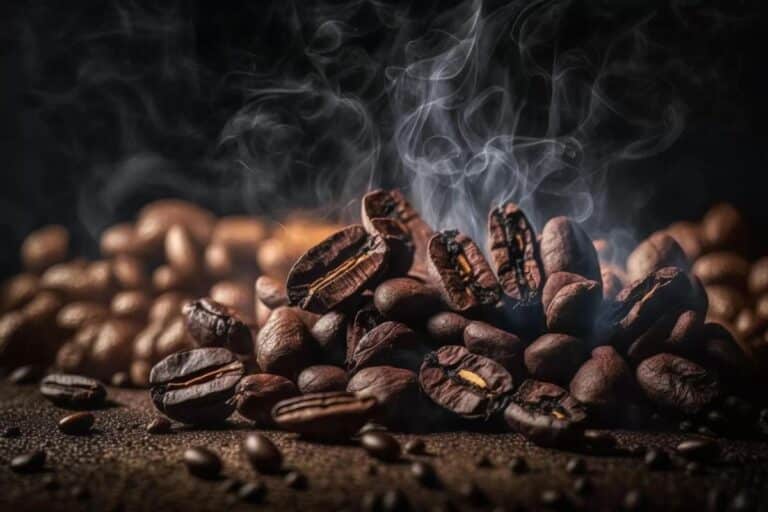Espresso is more than just a type of coffee; it’s an art and a key part of coffee culture everywhere. It first came from Italy in the early 1900s. People make espresso by pushing a little bit of almost boiling water through really fine coffee grounds. This method makes a strong, flavorful shot of coffee with a creamy foam on top, called “crema.” Espresso is the starting point for lots of favorite coffee drinks, like lattes, cappuccinos, and Americanos. Each drink begins with the bold taste of espresso.
What is an Iced Espresso?
An Iced Espresso is a coffee drink made by pouring freshly brewed espresso over a glass of ice, quickly cooling the coffee while preserving its deep flavor. It’s a versatile base for a range of iced coffee beverages, customizable with milk, sweeteners, and flavored syrups. This drink is especially popular in warmer weather, offering a strong and refreshing coffee experience.
Then there’s iced espresso, a cool take on the classic hot espresso. It’s perfect for hot weather or when you want a cold coffee. Iced espresso keeps the strong flavor and rich smell of regular espresso but adds a refreshing, chilly twist. It’s different from regular iced coffee, which you can make from any coffee. Iced espresso needs the strong espresso base for its intense taste and quick caffeine boost. This introduction shows how iced espresso puts a modern spin on traditional espresso, offering a cold, tasty choice for coffee lovers wanting something new.
Understanding Espresso
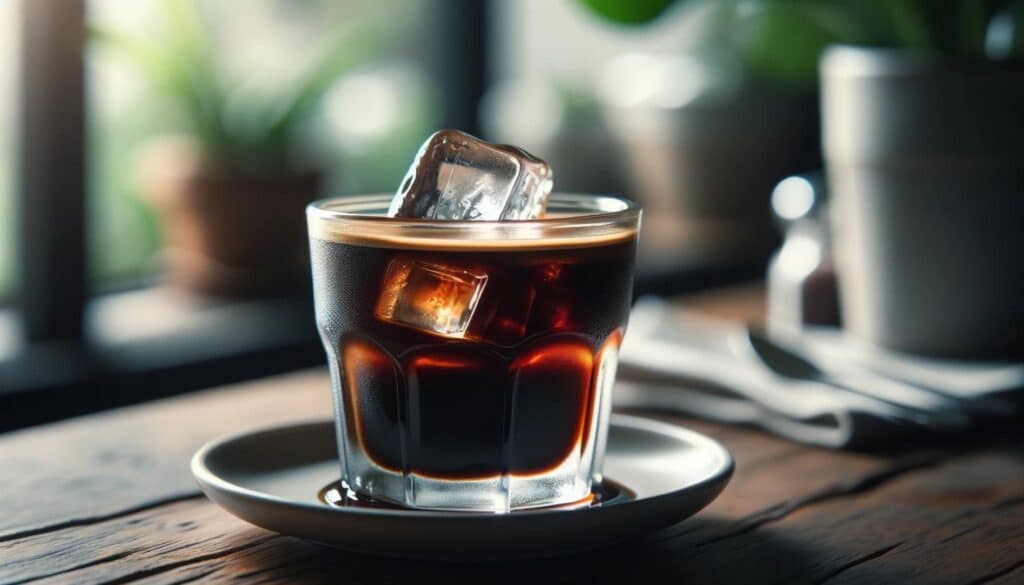
The Basics of Espresso: Definition and Brewing Process
Espresso is a concentrated form of coffee, renowned for its rich flavor and intensity. It is traditionally made using an espresso machine, which forces hot water through finely-ground coffee beans at high pressure. This process, typically lasting between 25 to 30 seconds, extracts the coffee’s oils, flavors, and aromas, resulting in a small, but powerful, shot of coffee. The ideal espresso shot is characterized by its complex layers: a rich, dark coffee body topped with a golden crema, which is the frothy layer that forms as air bubbles combine with the soluble oils of the coffee.
The art of making espresso is both precise and demanding, requiring a fine balance of the right grind size, water temperature, and pressure. This method of brewing coffee is distinct from other techniques due to the speed of extraction and the pressure involved, which are crucial for creating the signature intensity and depth of flavor associated with espresso.
Key Characteristics of Espresso: Taste, Caffeine Content, and Serving Size
Taste: Espresso boasts a robust, full-bodied flavor profile with a higher concentration of dissolved solids than regular coffee, which contributes to its stronger taste and thicker mouthfeel. The taste of an espresso can vary significantly depending on the coffee bean‘s origin, roast level, and the brewing technique, often featuring notes of chocolate, nuts, fruits, or spices. The presence of crema adds a slightly sweet and creamy texture, enhancing the overall sensory experience.
Caffeine Content: Despite its small size, a single shot of espresso (approximately 1 ounce) packs a significant caffeine punch, typically containing about 63 milligrams of caffeine. This is less than the total caffeine found in a standard 8-ounce cup of drip coffee, which can vary but averages around 95 milligrams. However, espresso’s caffeine concentration is much higher, delivering a quick and intense energy boost in a small volume.
Serving Size: Espresso is traditionally served in small amounts, with a single shot being around 1 ounce (30 milliliters) and a double shot (doppio) around 2 ounces (60 milliliters). This serving size reflects the beverage’s intensity and is designed to be savored quickly after preparation to appreciate its full range of flavors and the texture of the crema.
In summary, espresso stands out in the coffee world for its concentrated form, rich taste, and unique brewing method. Its intensity, both in flavor and caffeine content, makes it not only a beloved stand-alone drink but also a versatile base for a wide range of coffee beverages.
The Rise of Iced Espresso
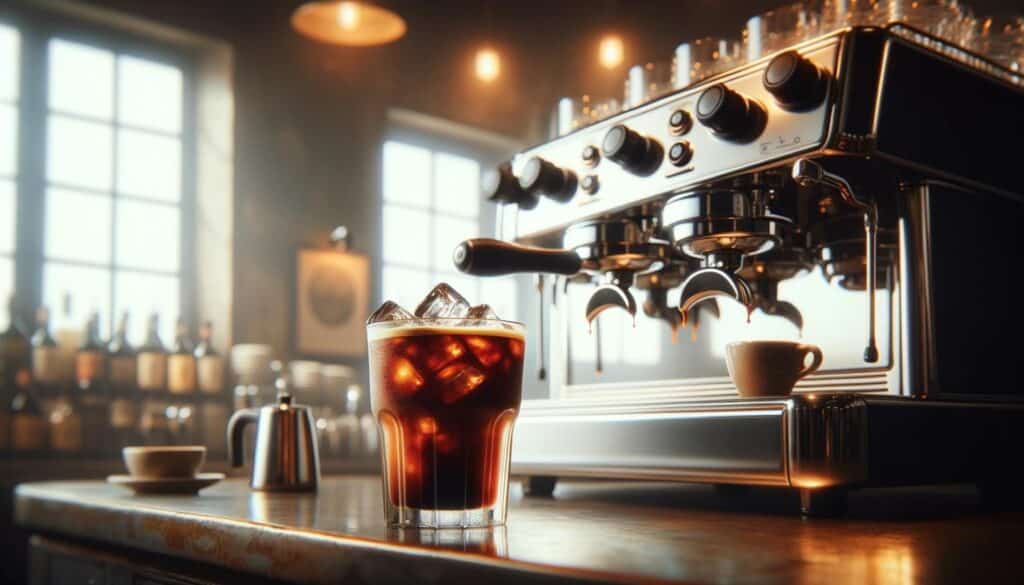
Historical Background: How and Where Iced Espresso Originated
People have enjoyed cold coffee drinks for centuries, with many cultures around the world having their own versions. But, pinning down exactly when iced espresso started is a bit tricky. It seems to have come about as coffee lovers wanted a cool version of their strong, concentrated espresso.
Iced espresso really started to take off with the rise of specialty coffee shops and the growing love for espresso-based drinks in the late 20th and early 21st centuries. In places with hot weather, like some countries in Southern Europe and the United States, iced espresso became a big hit, especially during the summer.
Why Coffee Lovers and Casual Drinkers Love Iced Espresso
Versatility and Refreshment: One of the key factors driving the popularity of iced espresso is its versatility. It serves as a refreshing alternative to hot coffee, particularly appealing during warmer seasons. Iced espresso can be enjoyed plain, with milk or alternative milk options, and can be easily customized with syrups and flavors to suit individual tastes.
Stronger Coffee Flavor: Iced espresso maintains the rich, robust flavor profile of traditional espresso but offers a different sensory experience due to its temperature. The cold serves to highlight certain flavors and can provide a more pronounced caffeine kick, which is appealing to those looking for a potent, yet refreshing, coffee drink.
Convenience: The rise of fast-paced lifestyles has also contributed to the popularity of iced espresso. It’s seen as a quick, convenient option that provides a rapid caffeine boost without the leisurely pace often associated with savoring hot espresso.
Social and Cultural Trends: The proliferation of coffee culture through social media and the increasing influence of specialty coffee shops have made iced espresso more than just a drink; it’s a lifestyle statement. Iced espresso drinks, often aesthetically presented, have become popular among younger generations who share their coffee experiences online, further fueling its popularity.
Health Consciousness: For some, iced espresso offers a healthier alternative to sugary iced coffee drinks. When consumed without excessive sweeteners or high-calorie milk options, iced espresso can be a low-calorie, high-antioxidant beverage choice.
In summary, the rise of iced espresso can be attributed to a combination of its refreshing nature, versatility, and the broader trends in coffee consumption and lifestyle. Its ability to deliver a strong coffee flavor in a cool, more palatable form during hot weather, along with its adaptability to various tastes and dietary preferences, has cemented its place in the coffee world as a beloved alternative to traditional hot espresso.
How Iced Espresso Differs from Traditional Espresso
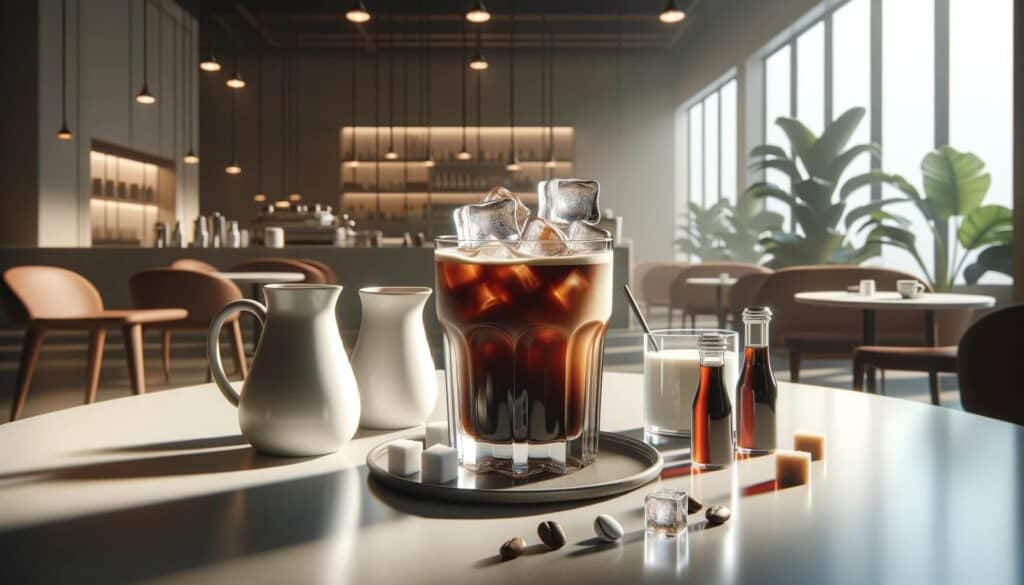
Preparation Differences: Brewing and Cooling Methods
Brewing: The initial brewing process for iced espresso and traditional espresso starts the same, with hot water forced through finely-ground coffee under high pressure. However, the path diverges immediately after brewing.
Cooling Methods: For iced espresso, the freshly brewed shot is rapidly cooled to halt the brewing process and preserve the espresso’s rich flavors. There are a few methods to achieve this cooling:
- Direct Cooling: The hot espresso is poured directly over ice. This method is quick but can dilute the espresso if not done carefully.
- Indirect Cooling: The espresso is brewed into a container set in an ice bath or refrigerated for a brief period before serving. This method reduces dilution but takes a bit longer.
- Flash Chilling: Espresso is brewed directly onto ice with a pre-calculated ice amount that chills the espresso instantly while minimally diluting it.
Flavor Profile Comparison: How Temperature Affects Taste and Aroma
Taste: Temperature plays a significant role in the perception of taste. Iced espresso tends to highlight certain acidic and sweet notes that might be less perceptible in hot espresso. The cooling process can also slightly mellow the bitterness, making the iced version seem smoother to some palates.
Aroma: The aroma of espresso is more volatile at high temperatures, which is why hot espresso has a very pronounced smell. When espresso is cooled to make an iced version, the volatility of aromatic compounds is reduced. This doesn’t mean iced espresso is less aromatic, but the aromas are perceived differently, often requiring a closer sip to fully appreciate.
Serving Suggestions: Glass vs. Traditional Espresso Cup
Glass: Iced espresso is typically served in a glass to accommodate the ice and to showcase the beauty of the drink. The choice of glass can vary from a simple tumbler to a more elegant stemmed glass, depending on the setting and personal preference. The transparency of the glass also visually enhances the experience, allowing one to see the rich color of the espresso mixed with ice, and any added milk or flavorings.
Traditional Espresso Cup: Hot espresso is traditionally served in a small, thick-walled porcelain cup that retains heat well. This presentation emphasizes the warmth and aroma, inviting quick consumption before the espresso cools too much, which can alter its flavor profile.
In conclusion, while both iced and traditional espresso start from the same brewing process, the differences in their cooling methods, temperature, and serving style contribute to distinct taste experiences and aesthetics. Iced espresso offers a refreshing alternative that appeals to those looking for the robust flavor of espresso in a cooler, more versatile form.
Making Your Own Iced Espresso

Creating an iced espresso at home is a simple pleasure that combines the robust intensity of espresso with the refreshing coolness of ice. Here’s how to make a perfect cup.
Equipment and Ingredients Needed
- Espresso machine or a stovetop espresso maker (Moka pot).
- Fresh espresso beans for grinding, or pre-ground espresso coffee.
- Burr grinder (if using whole beans) for even and consistent grinding.
- Filtered water to enhance the flavor of your espresso.
- Ice cubes made from filtered water.
- Glass for serving.
- Optional: Milk or milk alternatives, sweeteners, and flavorings according to taste.
Step-by-Step Brewing Guide
Brewing the Espresso
- Grind the Coffee: If using whole beans, grind them to a fine espresso consistency. You’re aiming for a texture somewhat finer than table salt.
- Prepare Your Espresso Maker: Fill the espresso machine or Moka pot with filtered water and add the ground coffee to the coffee basket. Tamp the grounds slightly if using an espresso machine.
- Brew: Brew your espresso according to the instructions of your espresso maker. Aim for a standard shot size (about 1 ounce per shot).
Cooling the Espresso: Ice Bath vs. Refrigeration
- Ice Bath Method: Immediately after brewing, place the container holding the hot espresso into a larger bowl filled with ice water. Stir gently to cool the espresso quickly. This method helps preserve the espresso’s flavor profile without diluting it.
- Refrigeration: Transfer the brewed espresso to a cold container and refrigerate for a few minutes. While less immediate than the ice bath, this method also reduces dilution.
- Direct Method: For an instant chill, pour the hot espresso directly over a cup filled with ice. Calculate the ice amount to account for dilution.
Serving Suggestions: With Ice, Sweeteners, and Milk Options
- Pour the cooled espresso over a glass filled with ice. For a less diluted drink, use larger ice cubes or freeze some espresso into ice cubes in advance.
- Sweeteners and Flavorings: Add sugar, syrup, or any preferred sweetener into the espresso while it’s still warm (before cooling) for better dissolution. Flavorings like vanilla, caramel, or chocolate can also be added.
- Milk Options: For a creamier drink, add a splash of milk, cream, or a milk alternative to the iced espresso. Stir well to combine.
Tips for the Perfect Iced Espresso
- Bean Selection: Choose high-quality beans with a roast profile that suits your taste. Lighter roasts tend to be more acidic and bright, while darker roasts are more robust and chocolatey.
- Water Quality: Use filtered water for both brewing and ice cubes to ensure the cleanest, purest taste.
- Ice Cube Recommendations: Consider making ice cubes from brewed coffee or espresso. This prevents your iced espresso from becoming watered down as the ice melts.
- Brew Strength: Experiment with the amount of coffee used for brewing. A slightly stronger brew can compensate for dilution from melting ice.
With these guidelines, you can enjoy the perfect iced espresso at home, customizing it to your personal taste preferences and enjoying a refreshing coffee experience anytime.
Variations of Iced Espresso
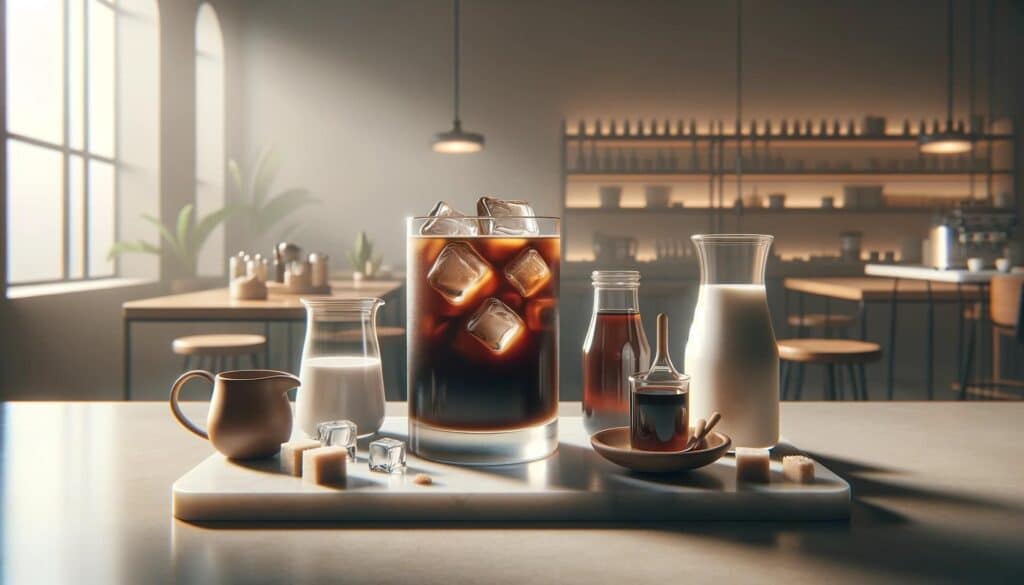
Once you’ve mastered the art of making iced espresso, the possibilities for refreshing coffee creations are endless. Here are some popular variations and creative twists to elevate your iced espresso experience.
Iced Espresso Macchiato
The “macchiato” means “marked” or “stained” in Italian, and this drink is traditionally made by “marking” espresso with a dollop of foamed milk. The iced version inverts this by adding a shot of espresso over a small amount of cold milk or cream, creating a layered effect.
- Preparation: Prepare a shot of espresso and let it cool slightly. In a glass filled with ice, pour about 2 tablespoons of cold milk or cream. Slowly add the cooled espresso shot on top, creating a distinct layer. The result is a strong espresso flavor with a hint of creaminess.
Iced Americano
An Iced Americano is a simple yet refreshing way to enjoy espresso. It’s made by diluting espresso with cold water, reducing its intensity but preserving its rich flavors, then served over ice.
- Preparation: Brew a double shot of espresso and cool it quickly using your preferred method. Fill a glass with ice, and pour the cooled espresso over it. Add cold filtered water to the espresso, typically in a 1:2 or 1:3 ratio of espresso to water, depending on your taste preference. Stir and enjoy a refreshing, coffee-forward beverage.
Iced Latte: How It Differs from Iced Espresso
An Iced Latte is creamier and milder than a straight iced espresso, thanks to the addition of milk. It consists of espresso mixed with cold milk over ice, offering a smoother, less intense coffee flavor.
- Preparation: Cool a shot of espresso, then pour it into a glass filled with ice. Fill the glass with cold milk (about 3/4 of the way), leaving room for the espresso. You can use any type of milk or milk alternative for different flavor profiles and textures. Stir well to combine the milk and espresso.
Creative Twists: Adding Flavors, Syrups, and Alternative Milks
Exploring creative additions can transform your iced espresso into a personalized treat.
- Flavors and Syrups: Infuse your iced espresso with a variety of syrups such as vanilla, caramel, hazelnut, or chocolate for a sweet twist. Adding spices like cinnamon or nutmeg directly to the espresso before cooling can introduce a subtle spiciness.
- Alternative Milks: Swap traditional cow’s milk for almond, soy, oat, or coconut milk to alter the texture and flavor profile of your iced espresso drinks. Each alternative milk brings a unique taste and creaminess, offering a way to customize your coffee experience.
- Herbs and Spices: For a truly unique iced espresso, consider muddling fresh herbs like mint or basil in the glass before adding ice and espresso. Spices such as cardamom or a pinch of salt can enhance the natural flavors of the coffee.
By starting with a solid foundation of well-prepared iced espresso, you can experiment with these variations and creative twists to discover your perfect summer coffee concoction. Whether you prefer the simplicity of an Iced Americano or the indulgence of a flavored Iced Latte, the versatility of iced espresso ensures there’s a refreshing coffee drink for every palate.
Health Considerations of Iced Espresso

Iced espresso, like its hot counterpart, offers a concentrated coffee experience but with a few health considerations to keep in mind, especially regarding caffeine content, and caloric and sugar intake in its various popular forms.
Caffeine Content in Iced Espresso vs. Hot Espresso
The caffeine content in an iced espresso is generally the same as in a hot espresso, assuming the same amount of coffee grounds and brewing method are used for each. A single shot of espresso typically contains about 63 milligrams of caffeine, although this can vary based on the coffee bean and exact brewing process. The main difference in caffeine content between iced and hot espresso drinks often comes from the size of the drink and the dilution factor when ice melts or when mixed with more water or milk than their hot counterparts.
- Iced Americano and other water-based iced espresso drinks might have a slightly lower perceived caffeine concentration due to the addition of water or ice, which dilutes the espresso. However, the total caffeine content remains unchanged unless more shots of espresso are added.
- Iced Lattes and similar milk-based iced espresso drinks maintain their caffeine content from the espresso shots but can seem less intense due to the significant amount of milk, which dilutes the espresso concentration.
Caloric and Sugar Content in Popular Iced Espresso Variations
The base of an iced espresso (just espresso and ice) is virtually calorie-free, with no intrinsic sugars. However, the caloric and sugar content can increase significantly with the addition of milk, cream, syrups, and flavored toppings. Here’s a look at some popular variations:
- Iced Espresso Macchiato: Generally low in calories if you’re using just a splash of milk or cream. However, using full-fat cream or sweetened flavored syrups can increase the caloric intake.
- Iced Americano: Contains very few to no calories, as it’s essentially espresso and water. It remains a low-calorie option unless sweeteners or syrups are added.
- Iced Latte: The caloric content can vary widely depending on the type of milk used. Skim or plant-based milks offer a lower-calorie option, whereas full-fat dairy milk increases the calorie count. Flavored syrups and toppings can significantly increase both sugar and calorie content.
Health Tips:
- For those monitoring caffeine intake, be mindful of the number of espresso shots in your drink, as iced versions can easily incorporate multiple shots.
- Choosing low-fat or plant-based milk options and minimizing or opting for sugar-free syrups can keep the calorie count lower in milk-based iced espresso drinks.
- When adding sweeteners, consider natural alternatives like stevia or monk fruit sweetener, which can provide the sweetness without the added sugars and calories.
Understanding these health considerations allows you to enjoy iced espresso in a way that fits your dietary preferences and restrictions, letting you savor the rich, refreshing taste of coffee without compromising your health goals.
Conclusion: The Appeal and Flexibility of Iced Espresso
Iced espresso proves that coffee culture is full of creativity and adaptability, bringing a cool new spin to the classic espresso. People love it for its strong taste, quick caffeine hit, and the refreshing chill it offers, especially in hot weather or for those who like their coffee cold and brisk. Its versatility also makes it popular; you can enjoy it plain or use it to make all sorts of tasty drinks.
You can make anything from a simple Iced Americano to a creamy Iced Latte, or get creative with flavored syrups and different kinds of milk. Iced espresso works well with many flavors and ingredients, so every cup can be a unique experience that reflects your personal taste and creativity.
It’s important to think about how much caffeine you’re drinking and how many calories are in your iced espresso, but the good thing is you can adjust it to fit your health and diet needs without losing out on taste or fun.
Encouragement to Try Making Iced Espresso at Home
Making iced espresso at home invites you to try new things and explore the wide world of coffee. It’s a chance to improve your barista skills and learn more about how coffee tastes and goes together with different flavors. With just the basic tools and a willingness to experiment, your kitchen can become your own café, where the menu is as big as your imagination.
Try different ways of making coffee, discover new coffee beans, and play with add-ins and toppings to create your perfect iced espresso. Whether you prefer the simple beauty of espresso over ice or love experimenting with different combinations, making iced espresso at home is full of chances to find out what you like best.
By getting into iced espresso, you’re not just making a drink; you’re joining a worldwide celebration of coffee in all its forms. So, get your espresso maker ready, pick out your favorite beans, and start your adventure to find your perfect iced espresso today.
FAQ: All About Iced Espresso
When is the best time to drink iced espresso?
The best time to enjoy an iced espresso depends largely on personal preference and lifestyle. Morning is a popular choice for many, as the caffeine kick can provide a refreshing start to the day. However, for those sensitive to caffeine, drinking it too late in the day might affect sleep quality. Consider your caffeine tolerance and how espresso impacts your energy levels when choosing the best time for you.
How does the caffeine in iced espresso affect the body?
The caffeine in iced espresso stimulates the central nervous system, which can increase alertness, decrease fatigue, and improve mood. The effects of caffeine vary from person to person, but generally include a quickened heart rate and increased metabolic rate. It’s important to monitor your body’s response to caffeine and adjust your intake accordingly, especially if you are sensitive to its effects.
Can you make iced espresso in advance?
Yes, you can brew espresso in advance and store it in the refrigerator to cool for iced espresso. When stored in a sealed container, it can maintain its flavor and freshness for up to 2 days. However, for the best taste, it’s recommended to use the espresso within 24 hours. Remember, the quality of your iced espresso will be best when the espresso is freshly brewed and cooled quickly.
How should iced espresso be stored?
If you’ve prepared espresso for later use in iced coffee, store it in a tightly sealed container in the refrigerator. This helps preserve its flavors and prevents oxidation. Avoid leaving brewed espresso at room temperature for extended periods to maintain its quality.
Can you freeze espresso for iced drinks?
Yes, freezing espresso in ice cube trays is a great way to prepare for making iced espresso drinks without diluting them as the ice melts. Espresso ice cubes can be used directly in your drink, providing a strong coffee flavor that intensifies as the cubes melt.
Is iced espresso healthier than regular iced coffee?
Iced espresso can be considered healthier than some iced coffee drinks, especially those that are pre-sweetened or contain high levels of cream and flavored syrups. Since iced espresso is simply espresso and ice, it contains no added sugars or fats unless you choose to add them. The key to a healthier iced espresso lies in the choice of additives like milk, sweeteners, and flavors.
Can adding milk or sugar to iced espresso reduce its caffeine content?
No, adding milk, sugar, or flavors to iced espresso does not reduce its caffeine content. These additions can change the drink’s taste, texture, and nutritional profile but the caffeine level will remain the same as in the original espresso shot.
How can I make my iced espresso stronger or weaker?
To adjust the strength of your iced espresso, you can vary the amount of espresso or water used. For a stronger drink, add more espresso shots. For a milder version, increase the amount of water or ice. Experimenting with the ratios will help you find the perfect balance according to your preference.
Are there any creative ways to sweeten iced espresso without sugar?
Yes, there are many creative and healthier alternatives to sweeten your iced espresso. Consider using natural sweeteners like honey, agave nectar, or maple syrup. For a calorie-free option, stevia or monk fruit sweeteners can provide sweetness without added sugars. Additionally, infusing your iced espresso with spices like cinnamon or vanilla can add a hint of sweetness without sugar.


